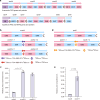Improving polyketide biosynthesis by rescuing the translation of truncated mRNAs into functional polyketide synthase subunits
- PMID: 39824802
- PMCID: PMC11742023
- DOI: 10.1038/s41467-025-55973-0
Improving polyketide biosynthesis by rescuing the translation of truncated mRNAs into functional polyketide synthase subunits
Abstract
Modular polyketide synthases (mPKSs) are multidomain enzymes in bacteria that synthesize a variety of pharmaceutically important compounds. mPKS genes are usually longer than 10 kb and organized in operons. To understand the transcriptional and translational characteristics of these large genes, here we split the 13-kb busA gene, encoding a 456-kDa three-module PKS for butenyl-spinosyn biosynthesis, into three smaller separately translated genes encoding one PKS module in an operon. Expression of the native and split busA genes in Streptomyces albus reveals that the majority ( >93%) of PKS mRNAs are truncated, resulting in a greater abundance of and a higher synthesis rate for the proteins encoded by genes closer to the operon promoter. Splitting the large busA gene rescues translation of truncated mRNAs into functional PKS subunits, and increases the biosynthetic efficiency of butenyl-spinosyn PKS by 13-fold. The truncated mRNA translation rescue strategy will facilitate engineering of multi-domain proteins to enhance their functions.
© 2025. The Author(s).
Conflict of interest statement
Competing interests: H.W., Y.L. and J.L. are inventors of the pending patent application submitted by Shandong University that covers the PKS module splitting method described in this study (CN2024118692176). The remaining authors declare no competing interests.
Figures







Similar articles
-
Discovery of Tricyclic Aromatic Polyketides Reveals Hidden Chain-Length Flexibility in Type II Polyketide Synthases.Int J Mol Sci. 2025 Aug 13;26(16):7801. doi: 10.3390/ijms26167801. Int J Mol Sci. 2025. PMID: 40869122 Free PMC article.
-
Tailoring of Prematurely Released Polyketide Intermediates in Piericidin Biosynthesis.J Nat Prod. 2025 Aug 22;88(8):1928-1935. doi: 10.1021/acs.jnatprod.5c00609. Epub 2025 Jul 27. J Nat Prod. 2025. PMID: 40717309 Free PMC article.
-
Mixing and Matching of Hybrid Megasynthases is a Hub for the Evolution of Metabolic Diversity in Cyanobacteria.Angew Chem Int Ed Engl. 2025 Jun 24;64(26):e202502461. doi: 10.1002/anie.202502461. Epub 2025 May 19. Angew Chem Int Ed Engl. 2025. PMID: 40246690 Free PMC article.
-
Structural insights and rational engineering strategies for modular polyketide synthases: A review.Int J Biol Macromol. 2025 Aug;319(Pt 3):145299. doi: 10.1016/j.ijbiomac.2025.145299. Epub 2025 Jun 16. Int J Biol Macromol. 2025. PMID: 40533022 Review.
-
Genome-based discovery of polyketides generated by trans-acyltransferase polyketide synthases.Methods Enzymol. 2025;717:317-347. doi: 10.1016/bs.mie.2025.03.002. Epub 2025 Apr 22. Methods Enzymol. 2025. PMID: 40651830 Review.
Cited by
-
Docking domains from modular polyketide synthases and their use in engineering.Nat Commun. 2025 Jul 22;16(1):6690. doi: 10.1038/s41467-025-61435-4. Nat Commun. 2025. PMID: 40695814 Free PMC article. No abstract available.
-
Reply to: Docking domains from modular polyketide synthases and their use in engineering.Nat Commun. 2025 Jul 22;16(1):6689. doi: 10.1038/s41467-025-61436-3. Nat Commun. 2025. PMID: 40695779 Free PMC article. No abstract available.
References
MeSH terms
Substances
Supplementary concepts
Grants and funding
LinkOut - more resources
Full Text Sources
Miscellaneous

